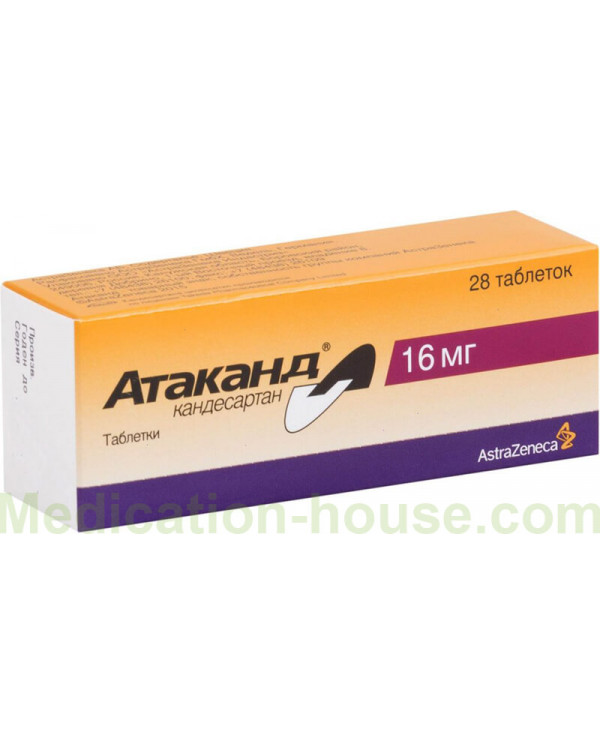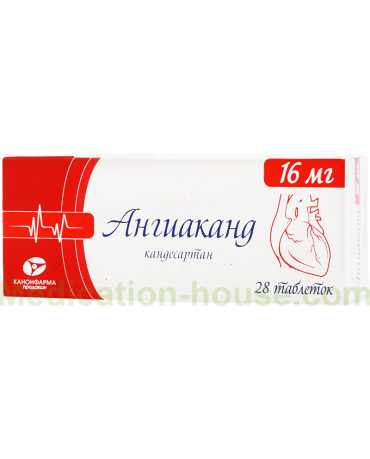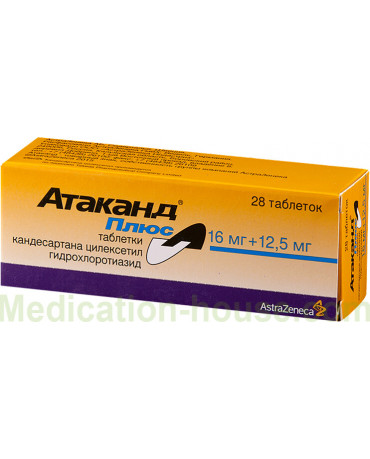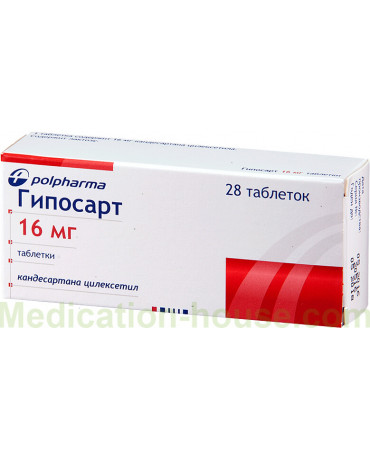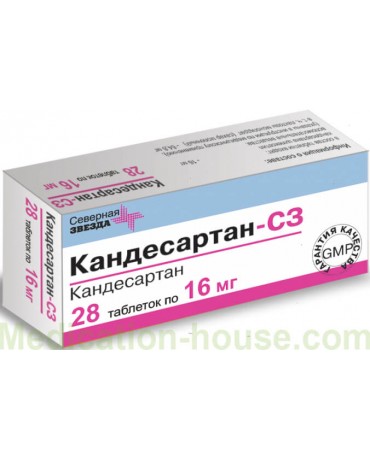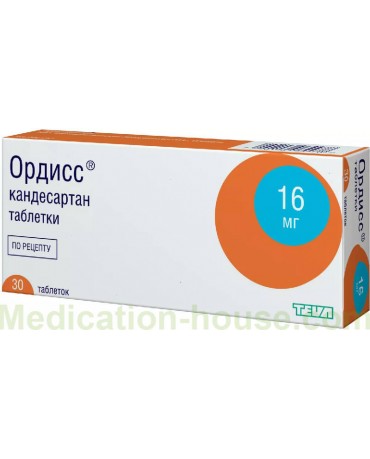Atacand instruction
You can buy Atacand here
Release form and composition
Atacand is produced in the form of round light pink tablets (14 pcs. In a blister, 2 blisters in a cardboard box).
Active ingredient: candesartan cilexetil, in 1 tablet - 8, 16 and 32 mg.
Excipients: calcium carmellose, magnesium stearate, hyprolose, iron dye red dioxide, lactose monohydrate, macrogol, corn starch.
Pharmacological properties
Atacand is an antihypertensive drug - an angiotensin II receptor antagonist that selectively acts on AT1 receptors.
Pharmacodynamics
Angiotensin II is a key hormone of the renin-angiotensin-aldosterone system that plays an important role in the pathogenesis of heart failure, arterial hypertension, and other diseases of the cardiovascular system. Its main physiological effects include vasoconstriction, stimulation of cell growth, normalization of water-electrolyte homeostasis, and stimulation of aldosterone synthesis. All these effects are due to the interaction of angiotensin II with AT1 receptors (type 1 angiotensin receptors).
Candesartan belongs to the group of selective angiotensin II receptor type 1 (AT1 receptors) antagonists. This substance is not an inhibitor of the angiotensin-converting enzyme (ACE), which is responsible for the conversion of angiotensin I to angiotensin II and degrades bradykinin, nor does it affect ACE and does not cause the accumulation of substance P or bradykinin. Comparison of candesartan with ACE inhibitors showed that cough, which is an adverse reaction, was less common in patients taking candesartan cilexetil. It is uncommon for candesartan to bind to receptors of other hormones and block ion channels through which the functions of the cardiovascular system are regulated. Due to AT1 blocking of angiotensin II receptors, an increase in renin activity, angiotensin I and angiotensin II levels, and a decrease in aldosterone levels in blood plasma are observed. These effects are dose-dependent.
In patients with arterial hypertension, the use of candesartan leads to a dose-dependent decrease in blood pressure, and the action of Atacand lasts a long time. The antihypertensive effect is associated with a decrease in total and peripheral vascular resistance, while the heart rate remains unchanged. There are no reports of cases of severe arterial hypotension after the introduction of the first dose of Atacand into the body, as well as the development of a withdrawal syndrome (“rebound” syndrome) after discontinuation of drug therapy. After taking the first dose of candesartan, its antihypertensive effect usually appears within 2 hours. With continued therapy with Atacand in a strictly defined dose, the maximum decrease in blood pressure is usually achieved within 4 weeks and remains throughout the entire course of treatment. When candesartan is prescribed once a day, a gradual and effective decrease in blood pressure is provided for 24 hours with a slight variation in the value of blood pressure in the intervals between doses of the drug. The combination of candesartan with hydrochlorothiazide enhances the antihypertensive effect. When taken together, candesartan and hydrochlorothiazide (or amlodipine) are well tolerated.
The effectiveness of Atacand is not determined by the sex and age of the patients.
Candesartan cilexetil increases renal blood flow, and the glomerular filtration rate increases or remains unchanged, while the filtration fraction and renal vascular resistance decrease. Reception of Atacand at a dose of 8-16 mg for 12 weeks does not have a negative effect on the lipid profile and glucose content in patients with type 2 diabetes mellitus and arterial hypertension. The clinical effect of the active substance Atacand on morbidity and mortality rates when taking the drug at a dosage of 8-16 mg (average 12 mg) once a day was studied in a randomized clinical study, which involved 4937 elderly patients (age 70-89 years, 21% of participants were 80 years of age or older), suffering from mild to moderate hypertension and treated with candesartan for an average of 3.7 years [the study was conducted as part of the SCOPE study (SCOPE - a study of prognosis and cognitive functions in elderly patients)]. Patients received placebo or candesartan cilexetil, supplemented if necessary with other antihypertensive drugs. With both regimens of therapy, an effective reduction in diastolic and systolic blood pressure was found (from 167/90 to 149/82 mm Hg in the control group of participants and from 166/90 to 145/80 mm Hg in the group of patients taking Atacand), and the drug was well tolerated. Quality of life and cognitive function were maintained at the proper level in both groups of participants in the experiment. There were no statistically significant differences in the incidence of cardiovascular complications (incidence of non-fatal stroke and myocardial infarction, cardiovascular mortality) between these two groups.
There were 26.7 cases of cardiovascular complications per 1000 patient-years in the group of patients taking candesartan, compared with 30 cases per 1000 patient-years in the group of patients receiving placebo (p = 0.19, 95% confidence interval (CI) - 0.75‒1.06, relative risk - 0.89).
The results of assessing the primary endpoint (complications from the cardiovascular system) and its components are as follows:
the occurrence of cardiovascular complications: in 242 patients with a primary event receiving candesartan cilexetil (N = 2477) and 268 patients in the control group (N = 2460), the relative risk (95% CI) was 0.89 (range 0.75‒ 1.06), p = 0.19;
cardiovascular mortality: in 145 patients with a primary event receiving candesartan cilexetil (N = 2477) and 152 patients in the control group (N = 2460), the relative risk (95% CI) was 0.95 (range 0.75‒1 , 19), p = 0.63;
nonfatal myocardial infarction: 54 patients with the primary event receiving candesartan cilexetil (N = 2477) and 47 patients from the control group (N = 2460) had a relative risk (95% CI) of 1.14 (range 0.77‒1, 68), p = 0.52;
nonfatal stroke: In 68 patients with the primary event receiving candesartan cilexetil (N = 2477) and 93 patients in the control group (N = 2460), the relative risk (95% CI) was 0.72 (range 0.53‒0.99 ), p = 0.04.
Prior to randomization, any prior antihypertensive therapy was standardized to hydrochlorothiazide 12.5 mg once daily. Another antihypertensive drug was added to the drug studied in a double-blind manner (placebo or candesartan cilexetil at a dosage of 8-16 mg once a day) if the systolic blood pressure was equal to or exceeded 160 mm Hg. Art. and / or diastolic blood pressure was equal to or greater than 90 mm Hg. Art. Similar additional treatment was received by 66% and 49% of patients who constituted the control group and the candesartan cilexetil group, respectively.
The results of the CHARM study, which assessed the reduction in mortality and morbidity with the use of candesartan in patients with chronic heart failure, showed that Atacand administration led to a decrease in the frequency of deaths and the need for hospitalization associated with exacerbation of chronic heart failure, as well as to normalization of the systolic function of the left ventricle.
As an addition to the main therapy, patients with chronic heart failure took candesartan cilexetil in a daily dose of 4–8 mg with an increase in the dose to 32 mg per day or to the maximum tolerated therapeutic dose (the average dose of the drug was 24 mg). The median follow-up was 37.7 months. After six months of treatment, 63% of patients who continued to take Atacand (89% of the total) received a therapeutic dose of 32 mg.
Participants in another study CHARM-Alternative (n = 2028) were patients with a reduced left ventricular ejection fraction (LVEF) of 40% or less who could not take an ACE inhibitor due to intolerance (mainly due to cough - 72%). The parameters of the frequency of the first hospitalization associated with chronic heart failure and deaths due to cardiovascular diseases were significantly lower in the group of patients taking candesartan compared with the placebo group (the confidence interval was 0.67‒0.89, p not exceeded 0.001, the risk ratio is 0.77). At the same time, the relative risk decreased by 23%. In this study, according to the requirements of statistics, to prevent 1 case of death due to cardiovascular complications, or hospitalization for chronic heart failure, 14 patients were required to be treated during the entire study period. In the group of patients taking candesartan, the combined indicator, which includes the indicator of the first hospitalization due to chronic heart failure (CHF), and the frequency of deaths, regardless of their causes, was also significantly lower (95% confidence interval, ranging from 0.7 to 0 , 92, the risk ratio is 0.8, p = 0.001). At the same time, there was a positive effect of the active substance Atacand on each of the components of this combined criterion: morbidity (an indicator of the frequency of admission to the hospital associated with CHF) and the frequency of deaths. The result of taking candesartan cilexetil was an improvement in the functional class of CHF in accordance with the NYHA classification (p = 0.008).
In patients with reduced LVEF (equal to or less than 40%) who took ACE inhibitors, a CHARM-Added study (n = 2548) was conducted, as a result of which it was found that a combined criterion including indicators of the first hospitalization associated with CHF and mortality caused by cardiovascular diseases was significantly lower in the group of patients receiving candesartan compared with the group of patients receiving placebo (95% confidence interval, ranging from 0.75 to 0.96, the hazard ratio is 0.85, p = 0.011), which corresponds to a decrease in the relative risk by 15%. In this experiment, in order to prevent 1 case of hospitalization for CHF or death caused by cardiovascular complications, 23 patients should be treated during the entire study period. The value of the combined efficacy indicator, which includes an assessment of the frequency of the first admission to the hospital for CHF and the frequency of deaths, regardless of their cause, was significantly lower in the group of patients taking Atacand (95% confidence interval, ranging from 0.78 to 0, 98, the risk ratio is 0.87, p = 0.021), which confirms the positive effect of candesartan treatment. The use of the drug contributed to the improvement of the functional class of CHF according to the NYHA classification (p = 0.02).
In patients with preserved systolic function (LVEF> 40%), the CHARM-Preserve study was conducted (n = 3023). In its course, in the groups of patients receiving placebo and candesartan, no statistically significant differences were found in the value of the combined efficacy indicator, including the frequency of the first hospitalization due to CHF and the frequency of deaths (95% confidence interval, ranging from 0.77 to 1 , 03, the risk ratio is 0.89, p = 0.118). A small numerical decrease in this criterion is explained by a decrease in the frequency of admission to the hospital for CHF. This study did not investigate the effect of Atacand on the frequency of deaths.
When the results of the three CHARM trials were analyzed separately, there were no statistically significant differences in death rates between the placebo and candesartan groups. However, this indicator was evaluated in the pooled population of CHARM-Added and CHARM-Alternative studies, as well as in all three studies (95% CI, 0.83 to 1, hazard ratio 0.91, p = 0.055). The decrease in the frequency of admission to the hospital for CHF and the frequency of deaths while taking candesartan was not determined by gender, age, and concomitant treatment. The efficacy of the drug has also been proven in patients who took ACE inhibitors in combination with beta-blockers, and it did not depend on whether the patient takes an ACE inhibitor in the optimal dose or not.
In patients with reduced systolic function of the left ventricle (LVEF equal to or less than 40%) and CHF, the use of candesartan provided a decrease in capillary pressure in the lungs and total peripheral vascular resistance, a decrease in aldosterone concentration, as well as an increase in the content of angiotensin II in the blood plasma and renin activity.
Pharmacokinetics
Candesartan cilexetil is an oral prodrug. After ingestion, it is rapidly biotransformed into candesartan by ether hydrolysis during absorption from the gastrointestinal tract. The substance does not possess agonist properties, slowly dissociates and reliably binds to AT1 receptors. The calculated absolute bioavailability is 14%. The maximum concentration of candesartan in serum is usually recorded 3-4 hours after taking the tablets. With an increase in the dose of Atacand within the range of recommended doses, a linear increase in the concentration of the active substance is observed. The pharmacokinetic parameters of candesartan are not determined by the sex of the patient. Food intake does not have a clinically significant effect on AUC (area under the concentration-time curve), therefore, when the drug is taken with food, its bioavailability does not significantly change. The degree of binding of candesartan to blood plasma proteins is quite high and exceeds 99%, and the volume of distribution is 0.1 l / kg.
The drug is mainly excreted from the body with bile and urine unchanged and only to a small extent participates in the processes of hepatic metabolism. Its half-life is about 9 hours, and there is no cumulation in the body.
The total drug clearance is approximately 0.37 ml / min / kg, and the renal clearance is approximately 0.19 ml / min / kg. Renal excretion of candesartan occurs by active tubular secretion and glomerular filtration. With oral administration of candesartan cilexetil, labeled with radioactive isotopes, approximately 26% of the dose taken is excreted through the kidneys unchanged and 7% - in the form of a pharmacologically inactive metabolite. At the same time, 56% of the dose taken is excreted in the feces in the form of unchanged candesartan, and 10% in the form of an inactive metabolite.
In elderly patients (over 65 years), AUC and the maximum concentration of the active substance increase by 80% and 50%, respectively, compared to younger patients. However, the incidence of side effects and the hypotensive effect when taking Atacand is not determined by the age of the patients.
In patients with mild to moderate renal dysfunction, the AUC and maximum concentration of candesartan increased by 70% and 50%, respectively, but the elimination half-life remained unchanged compared with patients with normal renal function. In patients with severely impaired renal function, AUC and maximum drug concentration increased by 110% and 50%, respectively, and the half-life increased by 2 times. In patients undergoing hemodialysis, the pharmacokinetic parameters of candesartan are the same as in patients with severe renal dysfunction.
In patients with mild to moderate liver dysfunctions, the AUC of candesartan is increased by 23%.
Indications for use
Arterial hypertension;
Heart failure and impaired systolic function of the left ventricle (used as an adjunct therapy to ACE inhibitors, or in cases of intolerance).
Contraindications
Liver dysfunction or cholestasis;
Hypersensitivity to the active substance or other components of Atacand;
Pregnancy and lactation.
This drug should be taken with caution:
Severe renal failure;
Bilateral renal artery stenosis;
Cerebrovascular disease and ischemic heart disease;
History of kidney transplant;
Age under 18.
Instructions for use: method and dosage
The tablets are taken regardless of the meal once a day.
In case of arterial hypertension, the initial and maintenance dose, regardless of age, is 8 mg per day, in some cases - 16 mg. If the therapy does not lead to a decrease in blood pressure, the combined use of Atacand with a thiazide diuretic is recommended. Mild to moderate renal impairment does not require dose adjustment. In case of mild to moderate liver dysfunction, the initial dose should not exceed 2 mg per day. The maximum antihypertensive effect during treatment with the drug is achieved within a month from the start of treatment.
With heart failure, Atacand should be taken at 4 mg per day at the beginning of treatment, subsequently the dose can be doubled every two weeks (up to 32 mg per day). Atacand is effective when used simultaneously with other drugs for chronic heart failure - beta-blockers, ACE inhibitors, cardiac glycosides and diuretics.
In old age and patients with impaired renal function, adjustment of the initial dose of the drug is not required.
Side effects
The attacks are generally well tolerated.
Side effects that occur when taking the drug do not depend on age and dose.
In the treatment of arterial hypertension, weakness, dizziness, respiratory infections, headache, and back pain most often develop.
In the complex treatment of chronic heart failure, Atacand can cause: a marked decrease in blood pressure, leukopenia, neutropenia, agranulocytosis, renal dysfunction, angioedema, hyperkalemia, hyponatremia, arthralgia, nausea, weakness, dizziness, headache, myalgia, urticaria, back pain , itchy skin, rash.
Overdose
According to the results of the analysis of pharmacological data concerning Atacand, the main symptoms of overdose are presumably dizziness and a clinically significant decrease in blood pressure. There are reports of individual cases of drug overdose (the dose did not exceed 672 mg of candesartan cilexetil), which ended with the recovery of patients without serious complications.
With a clinically pronounced decrease in blood pressure, symptomatic therapy should be prescribed and the patient's condition should be constantly monitored, as well as laid on his back, fixing his legs in an elevated position. If necessary, it is recommended to increase the volume of circulating blood plasma, for example, by intravenous administration of 0.9% sodium chloride solution. In some cases, sympathomimetic drugs are prescribed. Elimination of candesartan by hemodialysis is unlikely.
Special instructions
The drug can negatively affect kidney function. In case of renal failure, their performance should be regularly monitored. Such monitoring is also necessary in the treatment of myocardial insufficiency.
Calibration of therapeutic doses is mandatory in patients with weakened myocardial function in patients with kidney pathologies (with an elevated level of calcium in the blood, and in combination with ACE inhibitors), since in such cases, taking Atacand increases the risk of complications.
Application Atacand can cause renal artery stenosis, hypotension (in case of myocardial insufficiency), hypovolemia.
If, while taking Atacand, surgery and the use of anesthetics are planned, the risk of hypotension should be taken into account.
When a daily dose of 32 mg does not give the desired effect, the attending physician should decide on the further expediency of using the drug.
Patients with hyperaldosteronism are not prescribed pills, since they do not have the effectiveness of therapy with this group of drugs.
Atacand should be canceled immediately after pregnancy is diagnosed.
Influence on the ability to drive vehicles and complex mechanisms
Atacand does not affect the ability to drive and work with complex mechanisms, but it should be remembered that possible side effects in the form of weakness, increased fatigue and dizziness may appear.
Application during pregnancy and lactation
According to the instructions, Atacand is contraindicated for pregnant women. Patients receiving this drug should be informed of this prior to planning a pregnancy so that they can discuss alternative treatment options with a specialist. In the case of confirmed conception, the drug is immediately canceled and, if necessary, alternative therapy is prescribed.
Drugs that directly affect the renin-angiotensin-aldosterone system can provoke fetal developmental disorders (delayed ossification of the skull bones, oligohydramnios, impaired renal function) or negatively affect the newborn (development of hyperkalemia, arterial hypotension, renal failure), up to death, if the reception of Atacand continued during pregnancy.
To date, it remains unknown whether candesartan passes into breast milk. Due to the possible adverse effect on infants, Atacand is not recommended for use during lactation.
Pediatric use
The safety and efficacy of Atacand in children and adolescents under 18 years of age have not been proven, therefore, the drug in this category of patients is used with caution, under the supervision of a physician.
With impaired renal function
In patients with mild to moderate renal impairment [creatinine clearance (CC) ≥ 30 ml / min], there is no need for dose adjustment.
Clinical experience with the appointment of Atacand in patients with severe renal dysfunction or end-stage renal failure (CC <30 ml / min) is limited. In this regard, it is recommended to start treatment with a daily dose of 4 mg.
For violations of liver function
In patients with mild to moderate liver dysfunctions, the initial dosage is usually 2 mg once a day, but if necessary, an increase in the dose is allowed. Clinical experience with the use of Atacand in patients with severe liver dysfunction is limited, therefore, such patients and patients with cholestasis are contraindicated in taking the drug.
Use in the elderly
Elderly patients do not need to adjust the initial dose of Atacand.
Drug interactions
Taking Atacand in combination with drugs that include aliskiren is contraindicated in patients with moderate or severe renal failure (glomerular filtration rate less than 60 ml / min / 1.73 m2) or type 1 or type 2 diabetes. It is also not recommended for other patients.
The bioavailability of candesartan is not determined by food intake.
The combination of Atacand and non-steroidal anti-inflammatory drugs (NSAIDs) may increase the risk of renal dysfunction (including an increase in serum potassium concentration and acute renal failure), especially in patients with reduced renal function. Care must be taken when using these medicines together, especially in patients with reduced circulating blood volume and in elderly patients. Such patients need compensation for fluid loss and regular monitoring of renal function after the start of combination treatment and periodically against its background.
The combination of NSAIDs (including selective inhibitors of cyclooxygenase-2) and angiotensin II receptor antagonists sometimes leads to a weakening of the hypotensive effect.
In pharmacokinetic studies, the combined use of Atacand with enalapril, hydrochlorothiazide, nifedipine, warfarin, glibenclamide, oral contraceptives (ethinylestradiol / levonorgestrel), digoxin was studied - no clinically significant pharmacokinetic interaction was found.
The experience of using other drugs acting on the renin-angiotensin-aldosterone system indicates that concomitant treatment with salt substitutes containing potassium, potassium preparations, potassium-sparing diuretics and other drugs that can increase the concentration of potassium in the blood serum (for example, heparin), can provoke the development of hyperkalemia.
There are reports that the combined use of ACE inhibitors with lithium preparations leads to a reversible increase in the serum lithium content and various toxic effects. Such reactions can also be observed when taking angiotensin II receptor antagonists, therefore, it is necessary to constantly monitor the concentration of lithium in the blood serum with the combined use of these drugs.
Candesartan is involved in the metabolic processes in the liver, carried out with the participation of the isoenzyme CYP2C9, to a small extent. As a result of the studies on the interaction, the effect of the drug on the isoenzymes CYP3A4 and CYP2C9 was not revealed, and information on the interaction with other isoenzymes of the cytochrome P450 system is practically absent. The combination of Atacand with other antihypertensive drugs enhances the antihypertensive effect.
Terms and conditions of storage
The shelf life is 3 years.
Store at temperatures up to 30 ° C in a dark place out of the reach of children.
Reviews
Mostly, there are positive reviews about Atacand on the net. It is characterized by satisfactory efficacy and virtually no side reactions. Patients note that the drug lowers blood pressure well, preventing a stroke, and does not cause cough. However, many people do not like the high price of the drug, and there are also some reports of the uselessness of using Atacand for indications.
Terms of sell
You don't need a prescription to buy Atacand.

